Biopsychology
1/102
Earn XP
Description and Tags
(weeks 5 and 6)
Name | Mastery | Learn | Test | Matching | Spaced |
|---|
No study sessions yet.
103 Terms
How is neuronal communication electrochemical?
electro: inter-neuronal (within)
chemical- intra-neuronal (between)
movement of the action potential down the length of the axon is an electrical event, and movement of the neurotransmitter across the synaptic space represents the chemical portion of the process.
Glial cells
play a supportive role to neurons
neurons
interconnected information processors that are essential for all of the tasks of the nervous system
Semipermeable membrane
(what the neuron’s outer surface is made of) allows smaller molecules and molecules without an electrical charge to pass through it, while stopping larger or highly charged molecules
Soma
cell body that contains the nucleus of a neuron and its DNA
Dendrites
branch-like extension of the soma that receives incoming signals from other neurons
Axon
major extension of the soma (range from a fraction of an inch to several feet)
terminal buttons
Where the axon ends
Synaptic vesicle
(part of terminal buttons) storage site for neurotransmitters
neurotransmitters
chemical messengers of the nervous system
Myelin sheath
Fatty substance made from glial cells that coats the axon and acts as an insulator, increasing the speed at which the signal travels; it is not continuous and there are small gaps (Nodes of Ranvier) that occur down the length of the axon
Synaptic cleft
very small space between two neurons; an important site where communication between neurons occurs
receptors
proteins on the cell surface where neurotransmitters attach, they vary in shape; different shapes “match” different neurotransmitters (lock and key)
Environment of a neuron
fluid environment—it is surrounded by extracellular fluid and contains intracellular fluid
Neuronal membrane
keeps the two fluids separate—a critical role because the electrical signal that passes through the neuron depends on the intra- and extracellular fluids being electrically different
Membrane potential
difference in charge across the membrane (provides energy for the signal)
Resting potential
When the neuron membrane’s potential is held in a state of readiness
sodium (Na+) is at higher concentrations outside the cell and potassium (K+), is more concentrated inside the cell. The inside of the cell is slightly negatively charged compared to the outside
Depolarization
process of when the cell’s charge becomes positive, or less negative
Threshold of excitation
When the cell’s charge reaches a certain level and the neuron becomes active and the action potential begins.
peak action potential
When more pores of the neuronal membrane open, causing a massive influx of Na+ ions and a huge positive spike in the membrane potential. Here, the sodium gates close and the potassium gates open
Repolarization
after the peak, when positively charged potassium ions leave the cell
Hyperpolarization
when a cell becomes slightly more negative than the resting potential before it levels off, returning to the resting potential.
Action potential
the electrical signal that typically moves from the cell body down the axon to the axon terminals
All-or-none phenomenon
an incoming signal from another neuron is either sufficient or insufficient to reach the threshold of excitation, and there is no turning off an action potential once it starts
Reuptake
the neurotransmitter being pumped back into the neuron that released it, in order to clear the synapse
Biological perspective
Idea that psychological disorders like depression and schizophrenia are associated with imbalances in one or more neurotransmitter systems
Psychotropic medications
drugs that treat psychiatric symptoms by restoring neurotransmitter balance.
3 main neurotransmitters (for the test)
Acetylcholine: involved in muscle action, results in Increased arousal, enhanced cognition
Dopamine: mood, sleep, learning, results in increased pleasure, suppressed appetite
Serotonin: mood, results in modulated mood and suppressed appetite
Agonists
chemicals that mimic a neurotransmitter at the receptor site and, thus, strengthen its effects
Antagonists
blocks or impedes the normal activity of a neurotransmitter at the receptor
reuptake inhibitors
prevents unused neurotransmitters from being transported back to the neuron so they remain active in the synaptic cleft for longer durations, increasing their effectiveness
selective serotonin reuptake inhibitors (SSRIs)
Prevent reuptake, strengthen the effect of serotonin, giving it more time to interact with serotonin receptors on dendrites.
serotonin antagonist and reuptake inhibitors (SARIs)
can act as both antagonists and reuptake inhibitors (mainly used for depression)
Central Nervous System (CNS)
comprised of the brain and spinal cord
Peripheral Nervous System (PNS)
Made up of nerves, carrying messages back and forth between the CNS and the muscles, organs, and senses in the periphery of the body
Is divided into the somatic nervous system and the autonomic nervous system.
Nerves
thick bundles of axons
Somatic nervous system
Involved in conscious or voluntary actions; involved in the relay of sensory and motor information to and from the CNS (has motor neurons and sensory neurons)
Motor neurons
Carry instructions from the CNS to the muscles, are efferent fibers (moving away from CNS)
sensory neurons
carry sensory information to the CNS, are afferent fibers (moving toward the CNS)
autonomic nervous system
controls our internal organs and glands and is generally considered to be outside the realm of voluntary control (Divided into sympathetic and parasympathetic nervous systems)
Sympathetic nervous system
involved in preparing the body for stress-related activities
Parasympathetic nervous system
associated with returning the body to routine, day-to-day operations
Homeostasis
a state of equilibrium, or balance, in which biological conditions are maintained at optimal levels.
Fight or flight
allows the body access to energy reserves and heightened sensory capacity so that it might fight off a threat or run away to safety.
Endocrine system
of a series of glands that produce chemical substances known as hormones
Hormones
chemical messengers that must bind to a receptor in order to send their signal
secreted into the bloodstream and travel throughout the body, affecting any cells that contain receptors for them, making their effects widespread.
slower to take effect, and tend to be longer lasting.
regulate behaviors (such as aggression, mating, and parenting of individuals) and all sorts of bodily functions
ultimately controlled through interactions between the hypothalamus (in the CNS) and the pituitary gland (in the endocrine system).
behavioral endocrinology
The scientific study of of the interaction between hormones and behavior
Pituitary gland
descends from the hypothalamus at the base of the brain, and acts in close association with it
Called the “master gland” because its messenger hormones control all the other glands in the endocrine system, although it mostly carries out instructions from the hypothalamus
secretes growth hormone, endorphins for pain relief, and a number of key hormones that regulate fluid levels in the body.
Thyroid gland
hormones that regulate growth, metabolism, and appetite
Adrenal glands
sit atop our kidneys and secrete hormones involved in the stress response, such as epinephrine (adrenaline) and norepinephrine (noradrenaline).
Pancreas
an internal organ that secretes hormones that regulate blood sugar levels: insulin and glucagon. These hormones are essential for maintaining stable levels of blood sugar throughout the day by lowering blood glucose levels (insulin) or raising them (glucagon).
Gonads
secrete sexual hormones, which are important in reproduction, and mediate both sexual motivation and behavior.
female: ovaries; secrete estrogens and progesterone
male: testis; secrete androgens, such as testosterone.
Brain
comprised of billions of interconnected neurons and glia, a bilateral (two-sided) structure and can be separated into distinct lobes
Spinal cord
routes messages to and from the brain and has its own system of automatic processes, called reflexes.
The top of the spinal cord is a bundle of nerves that merges with the brain stem, where the basic processes of life are controlled. It ends just below the ribs
organized in 30 segments, corresponding with the vertebrae; each segment is connected to a specific part of the body through the PNS
In matters of survival, the spinal reflexes allow the body to react extraordinarily fast
protected by bony vertebrae and cushioned in cerebrospinal fluid, but when a part is damaged, everything below it is paralyzed
Neuroplasticity
Adaptations/changes in the nervous system due to personal experiences, developmental processes, or injuries
It can involve creation of new synapses, pruning of synapses that are no longer used, changes in glial cells, and even the birth of new neurons
Cerebral cortex
The surface of the brain associated with higher level processes such as consciousness, thought, emotion, reasoning, language, and memory (each cerebral hemisphere is broken up into 4 lobes)
Gyri (Gyrus)
The distinctive pattern of folds or bumps of the brain (allow us to separate the brain into functional centers)
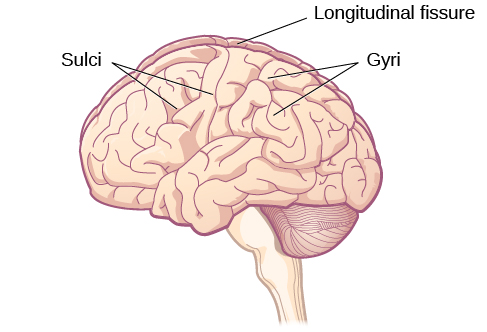
Sulci (sulcus)
The grooves of the brain (allow us to separate the brain into functional centers)
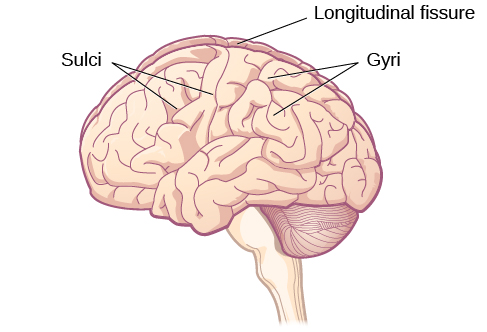
Longitudinal fissure
most prominent Sulcus; the deep groove that separates the brain into two halves or hemispheres (right and left)
Lateralization
specialization of function In each brain hemisphere
Corpus callossum
a thick band of neural fibers that allows the two hemispheres to communicate with each other and allows for information being processed on one side of the brain to be shared with the other side

Forebrain
largest part of the brain
contains the cerebral cortex and a number of other structures that lie beneath the cortex (subcortical structures): thalamus, hypothalamus, pituitary gland, and the limbic system (collection of structures).
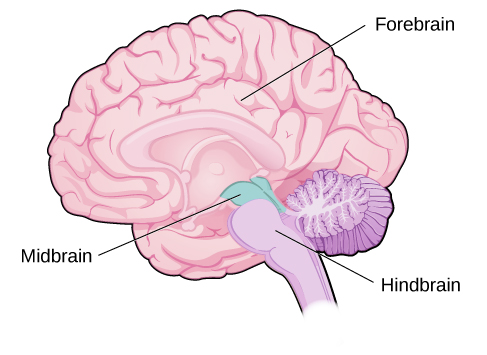
Frontal lobe
located in the forward part of the brain, extending back to a fissure known as the central sulcus; involved in reasoning, motor control, emotion, and language. It contains the motor cortex, prefrontal cortex, and the Broca’s area
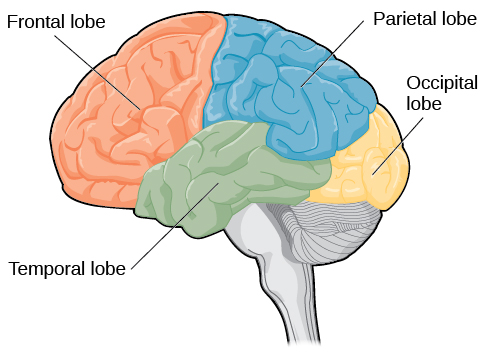
motor cortex
involved in planning and coordinating movement
Prefrontal cortex
Responsible for higher-level cognitive functioning
Broca’s Area
essential for language production
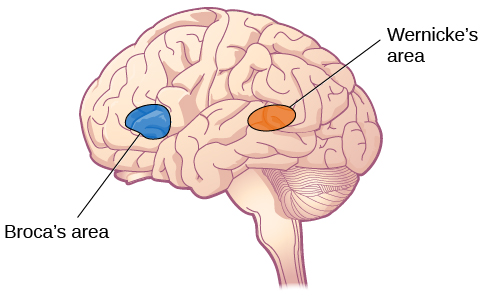
Primary motor cortex
Part of the frontal lobe; strip running along the side of the brain in charge of voluntary movements like waving goodbye, wiggling your eyebrows, and kissing; has a part devoted to each part of the brain

Parietal lobe
Located immediately behind the frontal lobe; involved in processing information from the body’s senses; contains somatosensory cortex
somatosensory cortex
essential for processing sensory information from across the body, such as touch, temperature, and pain; organized topographically, so spatial relationships that exist in the body are generally maintained on the surface of the somatosensory cortex (hand next to wrist)
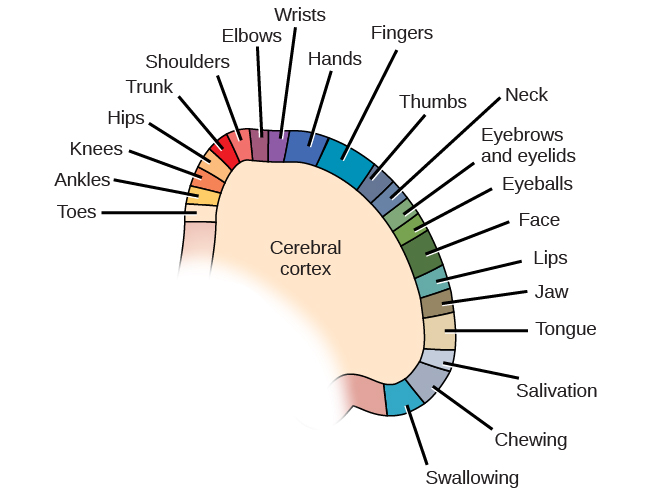
Temporal lobe
located on the side of the head (temporal means “near the temples”); associated with hearing, memory, emotion, and some aspects of language; contains auditory cortex and Wernicke’s area
auditory cortex
the main area responsible for processing auditory information
Wernicke’s area
important for speech comprehension

Occipital lobe
at the very back of the brain; contains the primary visual cortex, which is responsible for interpreting incoming visual information; organized retinotopically (close relationship between the position of an object in a person’s visual field and the position of that object’s representation on the cortex)
Thalamus
a sensory relay for the brain; all of our senses, with the exception of smell, are routed through the thalamus before being directed to other areas of the brain for processing
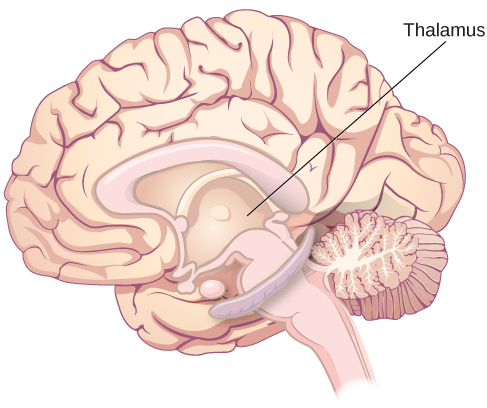
Limbic system
involved in processing both emotion and memory; the sense of smell projects here, so smell can evoke emotional responses in ways that other senses can’t; contains the hippocampus, the amygdala, and the hypothalamus (among others)
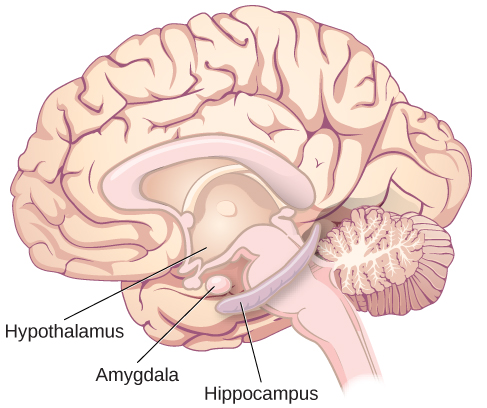
Hippocampus
essential structure for learning and memory
Amygdala
involved in our experience of emotion and in tying emotional meaning to our memories
Hypothalamus
regulates a number of homeostatic processes, including the regulation of body temperature, appetite, and blood pressure; serves as an interface between the nervous system and the endocrine system and in the regulation of sexual motivation and behavior.
Midbrain
comprised of structures located deep within the brain, between the forebrain and the hindbrain; contain the reticular formation, Substantia nigra, and Ventral Tegmental Area (VTA)
Reticular formation
centered in the midbrain, but extends up into the forebrain and down into the hindbrain; important in regulating the sleep/wake cycle, arousal, alertness, and motor activity.
Substantia nigra (”black substance”) and Ventral Tegmental Area (VTA)
contain cell bodies that produce the neurotransmitter dopamine; critical for movement; degeneration of these is involved in Parkinson’s disease; they are involved in mood, reward, and addiction
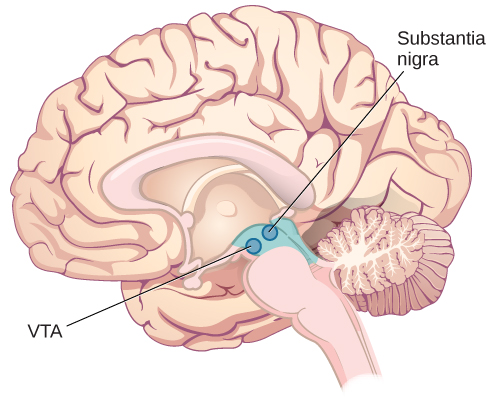
hindbrain
located at the back of the head and looks like an extension of the spinal cord; contains the medulla, pons, and cerebellum
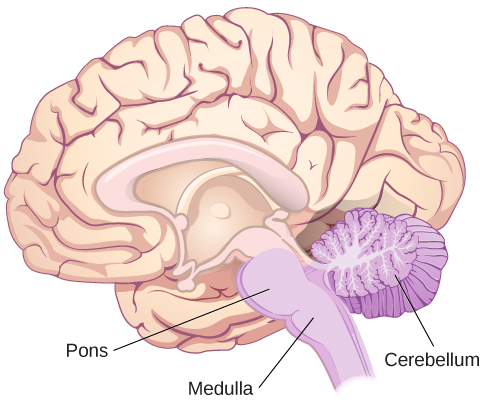
medulla
controls the automatic processes of the autonomic nervous system, such as breathing, blood pressure, and heart rate
pons
means “bridge”; connects the hindbrain to the rest of the brain; involved in regulating brain activity during sleep
Cerebellum
means “little brain”; receives messages from muscles, tendons, joints, and structures in our ear to control balance, coordination, movement, and motor skills; important area for processing some types of memories, such as procedural memory (memory involved in learning and remembering how to perform tasks)
Computerized tomography (CT) scan
taking a number of x-rays of a particular section of a person’s body or brain, passing them through tissues of different densities at different rates, allowing a computer to construct an overall image of the area of the body being scanned; often used to determine whether someone has a tumor, or significant brain atrophy.
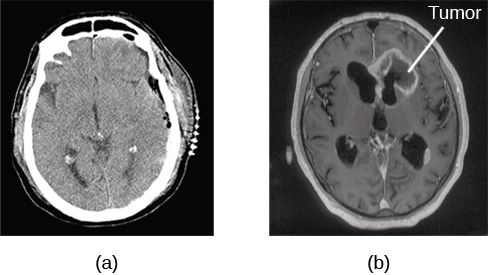
Positron emission tomography (PET) scan
an individual ingests a mildly radioactive substance (tracer); a computer monitors the movement of the tracer and creates a rough map of active and inactive areas of the brain during a given behavior; PET scans show little detail, are unable to pinpoint events precisely in time, and require that the brain be exposed to radiation (replaced by fMRI); combined with CT, PET technology is still being used in certain contexts

magnetic resonance imaging (MRI)
a person is placed inside a machine that generates a strong magnetic field that causes the hydrogen atoms in the body’s cells to move. When the magnetic field is turned off, the hydrogen atoms emit electromagnetic signals as they return to their original positions. Tissues of different densities give off different signals, which a computer interprets and displays on a monitor.
Functional magnetic resonance imaging (fMRI)
Like an MRI but also shows changes in brain activity over time by tracking blood flow and oxygen levels; provides more detailed images of the brain’s structure and better accuracy in time than PET scans
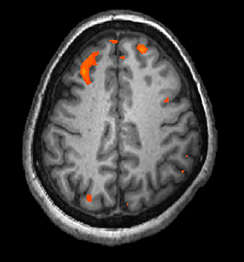
Electroencephalography
An array of electrodes is placed around a person’s head and the signals from them result in a printout of the electrical activity of their brain, or brainwaves, showing the frequency and amplitude of the recorded brainwaves, with an accuracy within milliseconds; helpful to researchers studying sleep patterns among individuals with sleep disorders.
Nature vs. nurture
Are you the way you are because you were born that way, or because of the way you were raised? Do your genetics and biology dictate your personality and behavior, or is it your environment and how you were raised?
Behavioral genetics
The science of how genes and environments work together to influence behavior
Quantitative genetics
the scientific discipline in which similarities among individuals are analyzed based on how biologically related they are
Heritability coefficient
varying from 0 to 1; measures how strongly differences among individuals are related to differences among their genes.
Chromosomes
long strings of genetic material known as DNA
deoxyribonucleic acid (DNA)
a double helix-shaped molecule made up of nucleotide base pairs
Genes
made up of sequences of DNA; control or partially control a number of visible characteristics, known as traits, such as eye color, hair color, etc.
Allele
A specific version of a gene
Ex. A gene may code for the trait of hair color, and the different alleles of that gene affect which hair color a person has
Genotype
A person’s genetic makeup
Phenotype
a person’s inherited physical characteristics, which are a combination of genetic and environmental influences